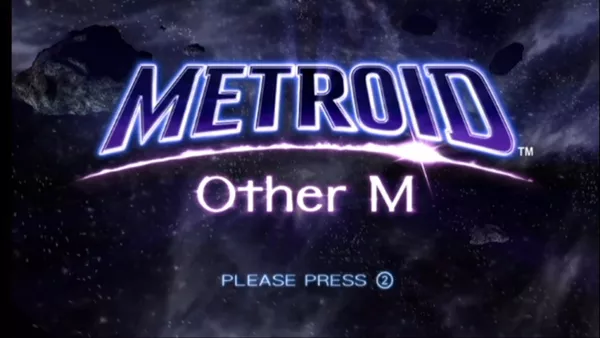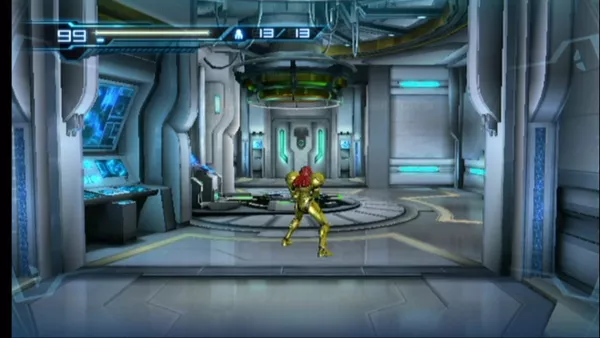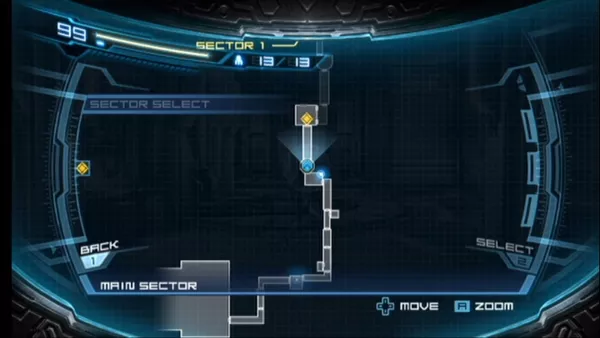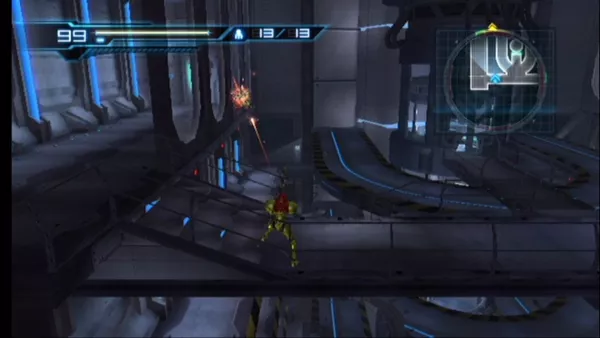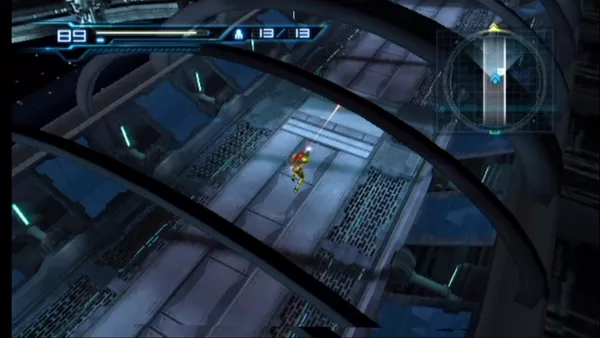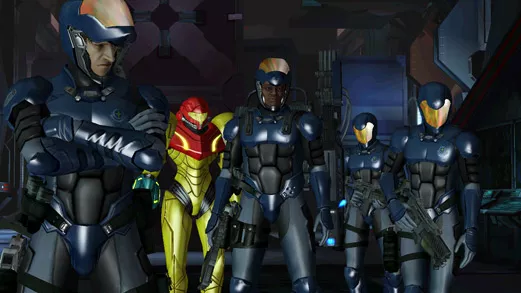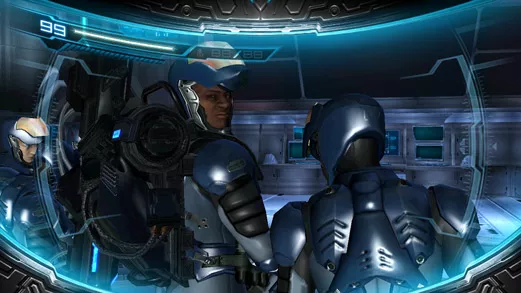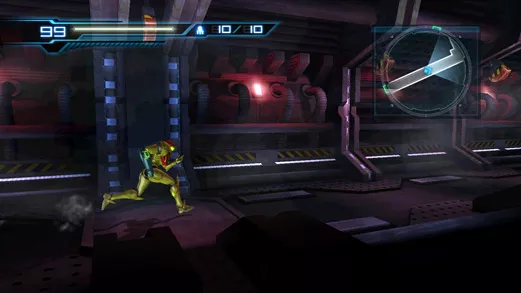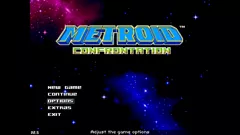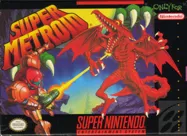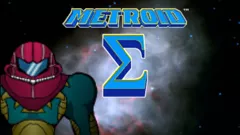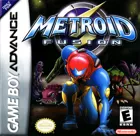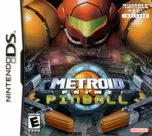Metroid: Other M
Description official description
Metoid: Other M follows recent console releases of Metroid games by being developed, like the Metroid Prime trilogy, by a studio outside of Nintendo. This time, rather than being handed to what, at the time, was a rookie studio, Metriod: Other M has been developed by veteran developer Team Ninja, notable for Dead or Alive and the Ninja Gaiden series.
Other M takes place, chronologically, after the events of Super Metroid, and before the events of Metroid Fusion. After a recuperation introduction, and a cinematic retelling of the final moments of Super Metroid, the game begins with Samus intercepting and investigating a distress call. The call comes from a space station (much like Metroid Fusion) that is in trouble. Samus meets up with her old military commander, Adam Malkovich and joins his team of Federation soldiers as they investigate the distressed station. Per the gameplay story, Samus is largely considered to already have many of her suit's abilities (such as missiles and bombs) in tact, but doesn't use them until Adam gives the authorization.
The game features a return to the side-scrolling gameplay of classic 2-D Metroid games, but in a hybrid form which also includes first-person shooter segments (utilized simply by pointing the Wii Remote at the television), and even 3rd-person “over the shoulder” segments for very small rooms. Targeting enemies is typically just a matter of aiming in the right direction, and specific shots are automatic in 2-D mode. In first-person mode, Samus can lock on to enemies to fire missiles. The Morph Ball returns, as expected, and operates in a similar manner to the popular Metroid Prime titles, with the camera zoomed in extremely close in tight environments. The over-the-shoulder 3rd-person view is mostly used for exploration of small rooms, and not combat. The game is played using only the Wii Remote without the Nun-chuck accessory.
As a staple of the series, Samus can again build up her armaments and weapons by collecting items found by exploring the game. This is in addition to the plot device that she doesn't use anything until authorized.
New to the franchise is ample use of cinematic cut-scenes, which are used to tell the back story of Samus, her past with Adam Malkovich, and her former military association. Also, rare for a Nintendo title, is ample spoken dialog from the title character--both in cinematics and story sequences, as well as monologues detailing Samus' perceptions and feelings through the story.
For the first time, Samus Aran’s overall agility is more in-line with her Super Smash Bros form than most previous Metroid titles and her combat catalog now includes finishing moves, dodges, and grapple attacks. All the new moves are designed around simplicity and speed--sometimes operating automatically if the right button is held--and the game’s combat has the arcade-intense feel of Team Ninja’s more recent Ninja Gaiden titles.
Pre-ordered copies of the game came bundled with an “Art Folio” containing sixteen cards featuring artwork from the game, with descriptions printed on the back. The cards are roughly the same size and shape of a DVD case.
Groups +
Screenshots
Promos
Videos
Add Trailer or Gameplay Video +1 point
See any errors or missing info for this game?
You can submit a correction, contribute trivia, add to a game group, add a related site or alternate title.
Credits (Wii version)
359 People (346 developers, 13 thanks) · View all
| Producer | |
| Director | |
| Story | |
| Cinematic Director |
|
| Engineering Lead | |
| Art Directors | |
| Assistant Director | |
| Animation Leads | |
| Environment Art Leads | |
| Character Art Lead | |
| Effects Art Lead | |
| Real-Time Cinematics Lead | |
| Audio Director | |
| Technical Art | |
| Engineering | |
| [ full credits ] | |
Reviews
Critics
Average score: 72% (based on 64 ratings)
Players
Average score: 3.3 out of 5 (based on 33 ratings with 2 reviews)
"M is for Moo," said Old McDonald
The Good
Ryu Hayabusa: "Back in the late Eighties...I remember watching you put me down for other games. I know I hurt you, never able to finish my game, and I apologize for the hardships in our relationship. You see, ever since my debut on the NES and Arcade, I have dreamed of greener pastures. I started out, just a Ninja on the streets. I've moved up to rocky landscapes, snowy slopes, wicked fast trains, and even Mount Rushmore. (Cut from Ninja Gaiden on NES, due to cutting off Theodore Roosevelt's mustache. Sorry Teddy. Forgive me?)
As a well known Ninja, I know I've accomplished alot as far as gracing the highest and most difficult of altitudes on our dear planet. Unfortunately, there is one place I still have yet to sneak upon...Outer Space. So, when I remind myself of the late Eighties, and the thousands of times when you threw my cartridge across the room, only to put in Metroid, I start to question my beliefs. Am I really any good? (Yes. Yes, I am. I am Awesome.)
Metroid: Other M makes me realize I am a great Ninja, and I really need to pollute the rest of the Galaxy with my good looks. (I'm really good looking. You should see the babes I hang with.) Other M has taken my remakes and reconstructed them into the Metroid universe. It's almost as if Team Ninja stuck my d**k in a blender with a Morph Ball and had Samus Screw Attack out. (And it tastes really good.)
Other M is like the Arcade version of Ninja Gaiden...it's fun, less frustrating, and very handsome. (I am so very handsome.) You should definitely play this game.
The Bad
Samus Aran: "..." (Thumbs Down)
The Bottom Line
Other M captures all the exciting elements of Metroid minus the extensive exploration. The story/cutscenes are ridiculously laughable, yet entertainingly bad.
Wii · by Theo Jones (9) · 2010
The Good
Finally here, the ambitious Metroid: Other M has arrived. And I am writing this review having meandered through the entirety of the game and stopped just shy of collecting all 100% of the items because, honestly, I just didn’t need those last four missiles.
Well then, one of the few things I can say that I really like about this is that it clearly shows Nintendo actually reaching out to work with third party companies a little more. That’s not on the game itself, but it shows some kind of growth by Nintendo.
Graphically, the game is pretty sharp. Expect a lot of the bright and shiny sheens that we’re used to from Team Ninja. Remember how shiny Ryu Hyabusa looked in Ninja Gaiden Black, and how sharp everything looked therein on the old Xbox? Or how Team Ninja brought out some shockingly impressive graphical feats on the Nintendo DS with Ninja Gaiden: Dragon Sword? So, graphically, the game is obviously in good hands. Characters are smooth, and clearly pretty massive in the poly counts. They also feature a vibrancy not seen on many Wii games with richer colors and shiny, moisture-like surfaces where applicable.
Generally, the gameplay is sharp and fun, at least during the generally mindless running and gunning segments. The action is generally nicely paced, though it can be a minor headache to have enemies reappear in a room after stepping out of it. The Prime games at least waited until the player got a few rooms away before repopulating them with baddies. Some classic weapons and items, such as the Space Jump and Screw Attack, and Speed Booster, work really well and are lots of fun. The game features a new item upgrade in the form of accelerators for the Charge Beam, which is pretty nice. That’s it, though.
Cinematics look very pretty and the pre-rendered cut scenes are nicely done. Is it the best I’ve ever seen? Hell no. This is just a pre-rendered cinematic, and I’ve seen better in many places, such as among the few pre-rendered scenes in Fable II. Thankfully, the game isn’t insanely heavily focused on marketing Samus with Dead or Alive-style sex appeal. Which is about the only thing they did right with her…
Samus has some cool new moves in her arsenal, largely made up of finishing moves, some of which are accomplished automatically.
There is a new move called “Concentration” that allows Samus to simply refill her missiles at any time, which is pretty convenient. It also has another use, but that’s covered in the next section. Save points are common and easily reached. As before, they also recharge health and missiles.
Many of the bosses are quite impressive, and look very good. Some are excellent throwbacks or revisits. One boss from Metroid Fusion makes a return, as well as one from Metroid II and one from Super Metroid. Unfortunately, as I’m sure everyone is aware, they felt the need to resurrect Ridley yet again, which I find annoying. I’m just so tired of that guy. I liked him in Super and I loved him in Prime 1 but after that, it got old.
After finishing the game, the “Bottle Ship” is opened up for some exploration and a final story element. This is the only time the game releases the player from the strict and non-Metroid-like linearity of the regular story.
All the cinematics in the game run up to something like two hours in the game, which is just too much for me. I'm now used to storytelling BioShock-style, which I think is the proper way to do it in a video game. However, what I'm getting at here is that they are all unlocked and can be viewed as a movie once the game is finished... for anyone willing to put up with over two hours of solid ham-fistedness. It's a good idea, it's just that the story...
For as dreadful as the story is (read on), all I can say is to thank whatever gods there may be (Jesus, Moses, Mohammad, Buddha, Cthulhu, Stephen Hawking, whatever) that they didn’t clutter up this game’s already awful narrative with a truly idiotic love story. I was really worried for a while there.
The Bad
As a long-time Metroid fan—this is my favorite game franchise—it pains me to say that this game is buried in questionable design choices and one of the worst written stories this side of a teenager’s notebook filled with half-assed anime fan fiction. Sounds harsh, doesn’t it? Trust me, it’s not as bad as the actual anger I felt when I completed the main story of Other M.
The story is my biggest overall complaint. At this point, I’ve seen it all from every legion of fanboy on the internet defending what is little more than generic, ham-fisted, anime trite which not only fails to add depth to the character of Samus Aran, but wastes considerable time assassinating her character and replacing it with an offensive female stereotype. I’ve seen it defended from the point of view of some people as if any depth and writing is good, and I’ve seen people who simply don’t know any better how mature narratives are written, and I’ve seen kids claiming that “it’s all like this in the Manga.”
I will now dismiss all this crap. For one thing, having any amount of writing and dialog does not automatically qualify as said writing and dialog as being good. Since I am also a pretty big movie nerd, I will point out the following as proof of my point: Battlefield Earth. This movie had an over-long science fiction story with all sorts of awful writing, nonsensical plot points, and dreadfully unlikable characters. Had they released the movie with less writing and a less elaborate plot, it’s likely it wouldn’t have sucked quite as bad. If the “future humans” had fought back against the “lame aliens” with less elaborate means, I might have found it believable. Instead, the story in that film tells us that caveman-like future humans learned to pilot magically un-aged 1000-year-old Harrier fighters successfully against unbelievable alien overlords. Just having any elaboration doesn’t instantly make it good.
This also applies to people who simply don’t understand what makes for a riveting, mature, deep narrative in entertainment media. BioShock, Fallout 3, Transformers: War for Cybertron, Eternal Darkness, Metroid Prime 1, etc. These are games that delivered thrilling, deep, character-driven, atmospheric narratives in a thoughtful, mature manner. Compared to these gems, Other M is amateurish, childish, ham-fisted, and horribly clichéd. There are plenty of games doing the “space marine thing” quite well, and more than enough pushing this same kind of stuff in general. Splicing that stuff into Metroid just feels wrong.
I don’t want to hear anything about how “Samus was written in the Manga” because let’s face facts here--that doesn’t matter at all here. In much the same way that the notorious novelizations of Doom bore no resemblance to the games, or the way the Resident Evil films turn a blind eye to their source material. There are exceptions to this rule, such as in War for Cybertron, which is deliberately written to be part of an existing continuity, but even that took several creative liberties, and in the end, it’s unclear to which continuity of that cluttered Transformers universe it actually belonged. For another thing, Metroid games have typically always been better received in Western countries, and is much less popular in Japan, so suddenly up-ending the very Western style of the series over the last decade for this is illogical.
So, what the hell is wrong with the story and writing? For one thing, it’s awash with clichés and predictability. The space marine types are all generic characters, and there is this cliché feeling that extra emphasis was made on the minority character because he’s the minority character. In much the same way that low-brow horror films either kill the one black guy right away, or they obviously make him the hero along with the predictable likable blond chick coughhouseonhauntedhillcough. This kind of obnoxious cliché use of minority characters could easily be fixed by having more than one of them in the damn story. Try not to misread me on this—the emphasis here made for a painfully predictable moment for the final story sequence that truly angered me. This isn’t a tirade about “minorities” in narratives, but of a hackneyed, predictable use of them.
Aside from this, the story is told in otherwise beautifully rendered cut-scenes—pretty much all of which last too long, tend to be repetitive, and are generally poorly acted. Just because there’s voice acting in the game doesn’t automatically make it a good thing. Samus is often stilted and it’s painful to realize that we waited so many years to finally hear a Nintendo character speak, and what they delivered up was a woman who drones on with endless monologues and no feeling.
Contrary to this, we have Samus written in such a profoundly shocking way that it’s like a sucker punch from Nintendo. Yeah, yeah, old Metroid games were heavy on atmosphere and exploration, but light on character development. Never-the-less, the impression was of a lone bounty hunter, a woman breaking free from negative female stereotypes who is strong and independent and fearless in the face of insurmountable foes. Here, if Samus was a male character, I’d say he was emasculated. Samus is not strong, she’s weak and incredibly dependent on luck and help from “strong male characters” than she is on her own very substantial skills. She freezes in her tracks and cowers, quite literally, like a little girl in the face of Ridley—a character she has dispatched so many times it’s completely lost its originality and is hardly fun any more. Even after facing this one foe, what, half a dozen times, she now freezes in her tracks when confronted by him? Shouldn’t she have seen this coming on a space ship filled with cloned creatures? Every single gamer in the world saw this coming!
That’s just one example of the way they ruined Samus’ character and nature. When she’s not being dry or intensely fearful, she’s a whiny spoiled brat for no apparent reason. This game has all the negative stereotypes one would associate with the time when women were in the military for the first time. She was the “silly little girl with a big attitude” when she was in the military, and when predictably meeting up with her old chums again, she’s not so much treated with respect as she is targeted for being that “little girl that used to hang with us big boys.”
So yes, the story is my biggest gripe with this thing. But it’s far from the only issue.
This game uses the Wii Remote and just the Wii Remote, with no other options. On paper, I’m sure it sounded alright to have players playing the game ye olde NES style holding the controller sideways while pointing to shoot missiles. In practice, it’s a hassle. While I’m sure it’s possible to adapt to this gameplay style, I generally found it frustrating. Most of the game is spent running around shooting while the game auto-targets shots from the arm cannon to enemies. Switching to a stationary first-person mode to fire missiles simply became an unneeded hassle after a while since the beam weapons took out most enemies pretty quickly. It also had the unfortunate issue of being occasionally disorienting while enemy characters moved around during the switch. Why we can’t just play with the Wii Remote and Nunchuck is a complete mystery. According to what I’ve read online, Team Ninja and Sakamoto wanted the game to be accessible to everyone, but the Wii comes with a Nunchuck attachment, so it’s obviously going to be accessible to everyone, physically. In fact, it’d be less of a hassle this way.
There is a dodge move in first-person mode accomplished, in theory, by swinging the Wii Remote sideways or pointing off-screen. However it’s supposed to be done, it was typically never successful. This means that while I was flicking the Wiimote all over the place, I was getting hit by baddies instead of dodging.
The auto-dodge feature in 3rd-person mode had a tendency to backfire, especially during a few boss battles where, rather than dodging and not being hit by the boss or an attack, I was actually hit twice.
Metroid games have always been about a solitary heroine facing extremely hostile alien creatures in brooding, dramatic, atmospheric environments rife with exploration, secrets, and depth. This core of any regular Metroid experience has been removed in Other M. Exploration feels like an afterthought to making this a run-n-gun-style action game. It’s generally over-simplistic (except for a few truly obtuse puzzles). Push switch, room changes, new solution is painfully obvious—or just kill all enemies in the room. In fact, killing all the enemies in any given room simply lights the map to the locations of any collectable items. As such, the feeling of accomplishment from discovering hidden items is largely thrown out the window. It doesn’t help much that the scanning from the Prime trilogy is largely relegated to some item in the room being highlighted, but having no real description of what it is aside from “a computer terminal” or the name of the weapon that will break the object being scanned. It’s like an overly-simplified joke version of the scanning from the Prime trilogy. It’s not even as good as the X-Ray scanning from Super Metroid because, typically, next to nothing can be learned or found with the scanning here. At least in Super Metroid, hidden items and paths would become visible.
In fact, the scanning seems to serve only two purposes—showing the life bar of boss characters or planting players in horribly asinine forced pixel-hunts like some bad point-and-click title from the early 90’s. Yes, this game has the equivalent of pixel-hunting. There are moments in the game where the action and everything else just stops, the player is stuck in first-person mode, and is forced to look around the current area until they stumble upon some relatively tiny “thing” to “scan” to further the story. Honestly, the first time this happened, I actually thought the game broke. I couldn’t fathom why any game would just stick me in some awful first-person mode with no emphasis on what the hell I was supposed to be doing!
The gimped scanning also creates for some annoying trial-and-error moments during boss battles since it’s never clear which works better—running around blasting charged shots or being the sitting duck and firing missiles. Switching back and forth between these two methods during an intense boss fight is more likely to create headaches than any sense of fun.
Another mind-boggling element of the gameplay comes from a strange combination of awful writing and bizarre gameplay design. Samus already has all her weapons and items. But, she’s just waiting—out of complete and utter politeness apparently—for her former commander, Adam Malkovich, to give her permission to use said item. The worst case of this—and you’ll read about this all over the internet—is a segment where we’re forced to run through a lava/volcanic section while taking damage the whole time. Samus, who clearly cared little for Adam’s orders in the past, suddenly would rather put herself in real danger than to risk disrespect and activate the damn Varia suit she already has! This is just retarded writing and game design. It also means that when an item is “allowed,” such as the Varia suit or Super Missiles, there is no feeling of accomplishment at all.
Where everything in previous Metroid titles was earned through often challenging gameplay and rewarded with a substantial feeling of accomplishment, here, it’s relegated to just a lame plot device. The exploration and item collection has been totally ruined, and with it, any senses of accomplishment the game might have offered. Worse yet, aside from being able to upgrade the Charge Beam, there are no new items in the game. Nothing. Zip. Nadda. This is pretty pathetic especially given that Retro Studios didn’t just give us a few new items—they gave us a multitude of new items, weapons, suits, and visors—all across three games. Here, they couldn’t give us anything new? What gives?
The “Concentration” move’s alternate use is to activate the emergency energy tanks that Samus can pick up through the game. While this sounds good in concept, it’s another sucker-punch nightmare to the groins of gamers. It takes roughly 3-5 seconds for the Concentration move to activate emergency tanks and refill some of Samus’ life. Try to remember, this was made by Team Ninja who are known for high-intensity action. Also keep in mind that they transplanted that high-intensity action into this game. The only time this move is ever going to be necessary is during boss battles given the ease of most regular enemies and the frequency of save points.
However, the majority of the bosses attack so quickly, and so steadily that there is almost never a time that this Concentration move can be done successfully. Once, I managed to squeeze behind some debris in the boss arena to hide enough to recharge, and another time, I faced one of the only slower-moving bosses and had ample time if I just planned it carefully enough. Normally, however, the odds are stacked immensely against the player being able to activate the move successfully, thus making it useless. And for the first time ever, energy pick-ups have been removed from a Metroid game, so don’t think you can just kill bad guys (the ones with the bosses) and expect to recoup any health that way. There is a theory that the Concentration move can be used should the boss be “incapacitated” during the battle, but here’s the problem with this scenario: It requires the necessary health loss at just the right time in the battle—when the boss just happens to be weakened—in order to be used; and typically, when the boss character reaches this point, it’s time for the “kill shot” anyway.
The music is largely forgettable—which is rare for a Metroid title. It does nothing for the game and is not the deep, atmospheric, often beautiful tunes found in Super Metroid or the Prime trilogy. On top of which, while the graphics are pretty good, they fail to topple Metroid Prime , and the gorgeous, awe-inspiring scenic vistas found in that trilogy are totally absent here. None of the environments inspire much looking around in pure awe. None of them are breathtaking or alive the way they are in the trilogy. They’re like little static, though decorative cages in a really nice zoo.
On top of all this, the story once again rears its ugly head again and adds to the problems of the environments in that the game is awash in forced linearity. There is almost no exploring or venturing about alone as it’s all replaced by Adam telling Samus to “go here” and “do this” and preventing her from using her abilities. It’s a lot like Metroid Fusion in this regard—previously what I considered the worst game in the series because of this linear nonsense gimping the crap out of the exploration which was formerly a hallmark of the Metroid franchise. At the point in the game where exploration and free movement is finally allowed (after finishing the main story), the efforts are hollow and unrewarding, and meandering about the cumbersome Bottle Ship actually borders on boring. On top of this, while there were any number of ways and routes to getting around in any previous title, there’s typically only one or two ways to get anywhere in this game, so there’s never a faster or more clever route.
Several sections of the game, and even a couple large story-heavy segments, force the players to trudge around in a 3rd-person, over-the-shoulder mode a la Resident Evil 4 or Gears of War. Unfortunately, the only thing that can be done is slow walking, meaning that there is no action, fighting, scanning, or real exploring. This switch in the viewpoint seems to be used to heighten some kind of tension in the story at points, but serves only as boring walking.
While it’s nice to see so many familiar faces, there are too few new enemy characters or challenges.
One final issue I have with this game is that it has the absolute worst loading times of any game on the Wii. That's right--the worst of any game on the Wii. Where the Prime trilogy took great pains and pride in delivering some of the smoothest, seemingly most load-free games ever made on a disk-based format, Other M excels only in turning back the clock to 1996. Load times aren't so much long as they are extremely frequent, and extremely obvious and annoying. For a game so set on being high-speed action, it routinely manages to have that action broken up by a stalled screen with "now loading..." plastered in the bottom right corner. It's not like the environments here are huge or anything, either--far from it in fact. Like I said, these are not the massive awe-inspiring vistas of anything from the Prime series. Rooms are small and boundaries plentiful.
Nintendo has previously prided itself on giving gamers seamless experiences in all their games, often taking great pains to hide load times, or eliminate them. Here, they're obvious and plentiful, and with such small rooms and environments, they're also utterly confusing. Frequently, during my charges through the ship, I would run into a stalled loading screen and not just at doors, but also in the middle of the action--in fact, it even happened during the famous "Metroid escape" sequence, and that's just about the worst time it can happen!
The Bottom Line
Yeah, I listed a whole boatload of negatives here. Here’s the deal: I am an absolutely huge Metroid nerd. I never hoped I’d love Other M, I flat-out expected that I’d love it. Because I love everything Metroid. Even though I previously considered Fusion the low point in the series, I still found ample enjoyment with it, including its stellar challenges and invigorating boss battles, not the least of which was the triumphant reveal of a massive Omega Metroid. I was so certain I’d love this that I preordered it the second I heard there was bonus stuff with preorders.
Unfortunately, as you can see, I feel cheated. Pretty much everything that made Metroid games great has been removed here. The atmosphere, the stunning environments, the deep exploration, the weapons and items… It’s all gone. In the end, it’s like this is “Metroid by numbers,” except that they colored outside the lines and ruined once-successful formulas. The game has exploration, item collection, varied environments, and boss battles—but all of it is gimped and in the end, I feel shortchanged. Okay, not all of it, some of the boss battles still kick a lot of ass, and I’d be hard-pressed to dismiss the true final battle in the game (in the after-game segment) as it’s just about the most impressive part of this game. In fact both “final boss battles” are great.
But the story… man, it’s just terrible. It’s cliché, it’s predictable, it completely ruins the mystique of a great classic game character. I’m not angry that Samus is speaking or that there are cut-scenes—I’m angry because her dialog is stilted and terrible, and that she’s whiny and pathetic. This is really the same woman who single-handedly and fearlessly worked to completely eradicate not only the Metroid species, but also the Space Pirates? The same woman who conquered all elements of deadly Phazon, even while infected herself? I don’t bloody think so.
This is a complete insult to the character many of us quite literally grew up with, and they took away all her strength to replace it with petty, weak, negative female stereotypes. Yeah, I said angry. I was so appalled by the end story sequence after finishing the main story of the game that I couldn’t even enjoy the end credits—something that is tradition for me. Sit back, feel a sense of accomplishment, watch the credits scroll by. Not this time. I was positively fuming. A great final battle was followed with another asinine pixel-hunt sequence and some truly hackneyed storytelling.
There is some fun here, and some nostalgic moments and things that are great. The game starts out quite brilliantly. It’s fun and engrossing and great, but roughly five or six hours into the game, things start to gradually worsen and it becomes clear that the writing is unlikely to ever improve. And the things that are bad are truly dreadfully bad. And they bog down the game in such a way that it ruins the experience. There’s very little that’s new, and what is new generally doesn’t work. Metroid by numbers, and colored outside the lines. This is probably the biggest let-down I’ve experienced in this generation.
This is an average action game at best, made worse by attempting to pass it off as a Metroid title. Things that should've been a great step forward for the series--such as the storytelling, character development, and action are all hampered by ill-fitting design choices, sloppy amateurish writing, and elements simply un-suited to the Metroid franchise. As it is, there is infinitely more depth to the storytelling written on the walls in any of the Prime games. I gotta hand it to them that they took up the challenge of making a silent protagonist talk, but the fact that they didn't bother to understand her at all is a huge insult. What they did here is the equivalent of taking Bruce Willis John McClane character from Die Hard and rewriting as if he was never strong, brave, independent, or resourceful. As if they suddenly made Die Hard 5 and John McClane spent most of the movie pissing his pants in fear, requiring help from everyone around him, and all his clever tactics were replaced by mistake-laden buffoonery. The fourth movie may have been released PG-13, but it still had the same old kick-ass John McClane in it. Samus is not kick-ass here. That trait doesn't exist in spoiled, whiny, melodramatic teenage girl stereotypes--because that's what we do have.
Keep in mind, I still consider Super Metroid as one of the single greatest games ever made, and Metroid Prime is right up there with it.
Wii · by ResidentHazard (3555) · 2010
Trivia
Game Flaw
There is a bug in this game that prevents some players progressing past the Desert Refinery in Sector 3. The bug causes the door to the next room to remain locked. It is triggered by the way the player acted earlier in the game. After the player gets the "Ice Beam", they defeat the enemy in the next room. If the player then goes back into the room where they got the "Ice Beam" from then the door in Sector 3 will remain locked.
Players encountering this problem must contact Nintendo to have their save file corrected.
Analytics
Upgrade to MobyPro to view research rankings and price history! (when applicable)
Identifiers +
Contribute
Are you familiar with this game? Help document and preserve this entry in video game history! If your contribution is approved, you will earn points and be credited as a contributor.
Contributors to this Entry
Game added by ResidentHazard.
Wii U added by Michael Cassidy.
Additional contributors: piltdown_man.
Game added September 24, 2010. Last modified November 20, 2024.



